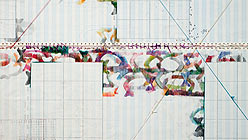Sonya Rapoport’s Pairings of Polarities at Kala Gallery in Berkeley is full of mirth, myth, and politics. Drawings, installations, video and artifacts each provide a different perspective on this artist’s broad output, her political satire and her sense of humor. In this retrospective of several decades of artistic investigation, Rapoport explores our dependence on the power of religion and technology, lacing these subjects with a well-founded fear of what these forces may become.
Pairings of Polarities focuses primarily on long-term projects with interactive elements that keep them current. An early adopter (and transformer) of new technologies into her art practice, Rapoport pioneered territories that have become mainstays of the digital: drawings that explore data as their subject, user-generated prompts that scrutinize the role of the computer in our decision-making process, and intricate charts that weave encyclopedic content into an experience more aesthetic than didactic. Engaging Rapoport’s work is like reading a pictorial dictionary without rules: margins are askew, diagrams overlap, and conflicting information vies for the title of truth.

Sonya Rapoport, “Christo and Cornell” (detail). Graphite and gouache, 1976.
Most striking in the exhibition is a series of works titled “Digital Mudras.” Rapoport began this multi-faceted project in the early ’80s — it received its first public exhibition at Kala in 1987. Using the gallery as a church-laboratory-cum-clinic, viewers were passed through a number of “stations” where their feelings were recorded, transcribed, and analyzed by philosophers, palmists, and HAL-esque computer programs. The output of these processes was an indecipherable biorhythmic chart or a series of iconic diagrams based on the Mudras (a Sanskrit word meaning gesture). The viewer entered his or her “Digital Mudra” experience by being asked to explain their emotions and left with a piece of hard data, a drawn-out joke as the earlier emotions became lost in translation.
Fortunately there are as many ways to engage this piece as in its earlier iterations. One can watch a documentary video of the ’87 show, view a series of photographic collages, put a selection of personal Mudras onto a wall, or even choose printed Mudras to take home (I found myself drawn to “Greeting,” “Ocean,” and “Wings of Bird”). In a brilliant Baldessarian slideshow, Rapoport pairs the Mudras with images of politicians making vague hand-gestures scoured from the newspaper. Nicolas Sarkozy’s fist-pump (taken from an article about a debt crisis) is interpreted by the Mudra “APPROVAL * AGREEMENT * CONSENT.” Just as the photojournalist isolates a gesture from a speech and the editor explicates that gesture with text, so does Rapoport insure the impossibility of communication by adding one more layer between the signifier and the signified.




